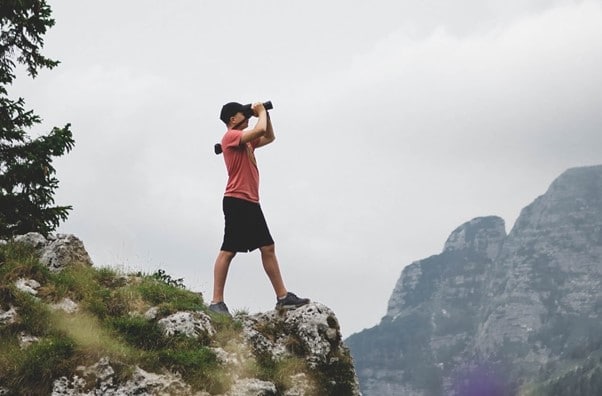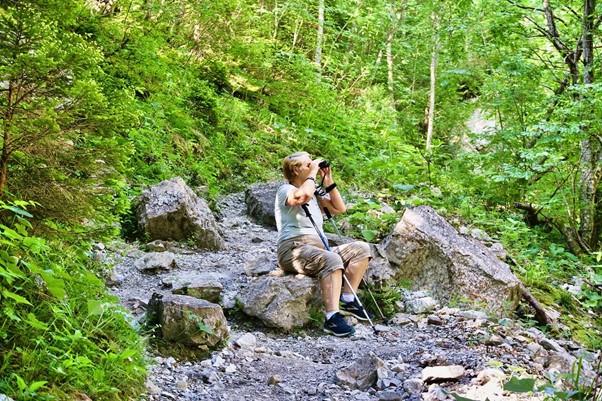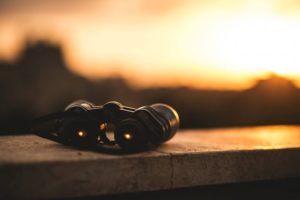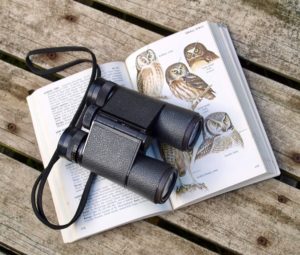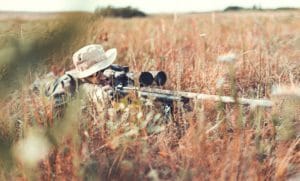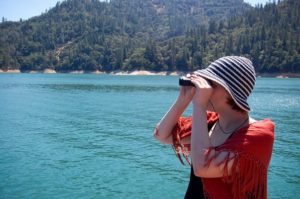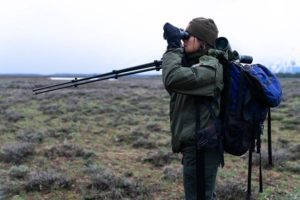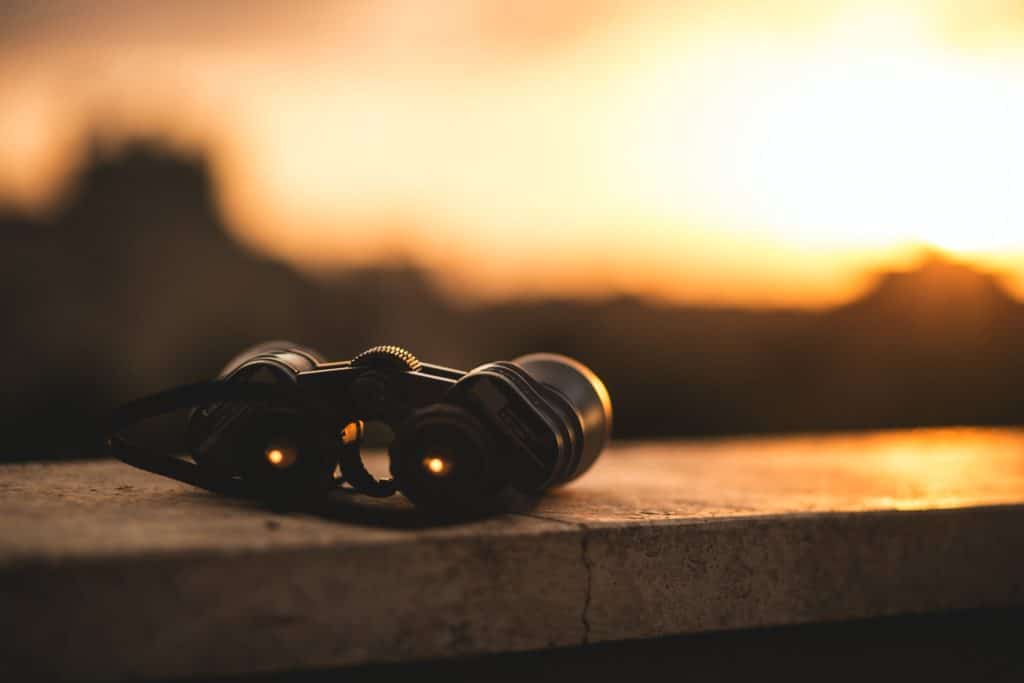This article includes affiliate links. If you choose to purchase any of the products discussed in this article, we may receive a small commission.
Hiking is a breath-taking activity, not just because of physical exertion but because of the natural and beautiful surroundings you can hike in. However, looking at the view with a naked eye doesn’t always get you as close as you want to be. Binoculars can make the perfect hiking companion and enhance your visual experience.
Unfortunately, deciding on the right pair isn’t straightforward—there are many types of binos, all suited to different uses.
So, especially for you hikers out there, we’ve compiled and reviewed this list of the best binoculars for hiking.
- Vortex Optics Diamondback HD 8×28
- Celestron Nature DX 8×32
- Zeiss Conquest HD 8×32
- Leica Ultravid BR 8×20
- Nikon Trailblazer 8×25
- Nikon Prostaff 3s 8×42
- Celestron Outland X 8×25
- Leupold BX-1 Rogue 10×25
How to Choose the Best Binoculars for Hiking

Selecting the ideal binoculars for hiking can be tricky if you’re unaware of the technical terms. So before you check out our best hiking binoculars, we outline some of these terms to clear up any confusion. We’ll also discuss the ideal specifications for the perfect hiking binoculars.
Magnification and Aperture
When looking at a pair of binoculars, you’ll often see two numbers, such as 8×42 written on the focusing wheel.
The first number represents the magnification, which tells you how many times larger something will appear. If you have a pair of 8×42 binoculars, objects will appear eight times larger through the binoculars than when you look at them with the naked eye.
The second number signifies the diameter of each objective (front) lens in millimeters. In our example, the diameter is 42 millimeters. Binoculars with a broader aperture allow more light in making the image brighter.
A magnification of 8× or 10× with an aperture of 28 or less is ideal for checking out the landscape while hiking. Binoculars of this size will be compact, lightweight, and easy to stuff into your backpack.
If you prefer to take in the wildlife when you’re out trekking, opt for the lesser magnification. But, you’ll want the aperture to be larger; 8×32 and 8×42 are popular amongst birdwatchers.
Exit Pupil Size
The best exit pupil size depends on where and when you go hiking. The exit pupil isn’t that important if you generally walk in bright daylight. However, if you venture out in low-light conditions, an exit pupil of 5 millimeters or above is best to avoid vignetting.
You can work out the exit pupil size by dividing the aperture by the magnification. For example, the equation for a pair of 8×42 binoculars would be 42÷8, which means the exit pupil size is 5.25 millimeters.
Field of View
The field of view (FoV) is what you can see when looking through a pair of binoculars. Manufacturers measure the FoV in two ways; linear and angular.
Linear: The linear FoV is the width of the area you can see. When shopping for binoculars, you might notice a set of numbers like 358/1000. This example means you can see 358 feet panoramically when standing 1000 yards away.
Angular: Manufacturers measure the angular FoV in degrees. You can convert angular FoV to find the linear FoV by multiplying the angle by 52.5. For instance, an angular FoV of 6-degrees multiplied by 52.5 results in a 315/1000 linear FoV.
The FoV best suited to hiking depends on what you want to look at when you’re out and about.
Magnification affects the FoV. The higher the magnification, the more the FoV is reduced.
If you have a small FoV, anything that moves will blur. So, if you’re purchasing binoculars to look at animals while you’re trekking through the hills, a larger FoV with lower magnification is more desirable.
However, if you want a pair of binoculars purely for geographical purposes, high magnification with a smaller FoV is ideal.
Eye Relief
Eye relief is the distance you can hold your eye from the eyepiece lens without disrupting the FoV. Many binoculars have adjustable eye relief, stating the maximum on the specifications.
Having long eye relief is particularly important if you wear glasses because your eye will sit further away from the lens.
If you’re near or long-sighted, you may not need to wear glasses while using binoculars. However, if you wear spectacles for conditions like astigmatism, aim for a minimum of 15 millimeters of eye relief.
Focusing Wheel and Diopter
For a clear image when using binoculars, you’ll need to adjust the focus using the focussing wheel and diopter.
Most focussing wheels are in the center of a pair of binoculars. By turning the focusing wheel, both barrels adjust simultaneously.
However, many people have different vision qualities in each eye. The diopter allows you to adjust the right eye independently to the left to compensate for these differences.
You’ll usually find the diopter on the right barrel, but some binoculars will have a central diopter.
Coatings
Lens coatings: Lens coatings are applied to the lenses to reduce reflection and enhance light transmission and contrast. When looking at the specifications, you may see terms like coated, multi-coated, or fully multi-coated lenses.
A coated lens means a single surface has one layer of coating applied, whereas multi-coated suggests multiple surfaces and/or multiple coatings.
Fully multi-coated lenses offer the best light transmission. It means that both inner and outer surfaces of the lens are multi-coated, minimizing reflection and glare.
Phase coatings: In addition to lens coatings, some manufacturers apply phase-coatings to optimize light transmission in roof prism binoculars.
When the different wavelengths of colored light shift through a prism they’re thrown out of sync. This interference causes a reduction in brightness, sharpness, and color fidelity.
Covering roof prisms in a dielectric layer known as a phase-coating helps all colored light reach your eye simultaneously to produce a sharp, crisp image.
Roof Prisms vs. Porro Prisms
The prisms in binoculars affect image sharpness and brightness, length, and weight. The two main types of prisms are; roof prisms and Porro prisms.
Roof prisms: The advantage of roof prisms is that they allow for a lighter, more compact design, great for hiking. However, due to the complexity of the manufacturing and testing process, roof prisms are generally more expensive.
Roof prism binoculars are also more susceptible to losing contrast because the light beam is split in two then recombined. For this reason, they need to have phase coatings to increase color fidelity.
Porro prisms: Porro prisms have a simple structure and don’t need phase coating. This simplicity makes them cheaper to produce. However, the design has to be bulkier due to the construction of the optical path.
Both types of prisms have their advantages, but for hiking, roof prisms are more convenient because of their size and weight.
Prism Material
The material of the prism affects image clarity. Arguably, the most common material used to produce prisms for binoculars is BK7 glass. A pair of binoculars with BK7 prisms will have a blurred or shaded edge to the exit pupil, which can cause chromatic aberration.
Chromatic aberration occurs when the lens fails to refract wavelengths of colored light simultaneously. As all colors diffract differently, the image can become blurred.
Higher-end prisms made from BAK4 glass prevent chromatic aberration. BAK4 is a high-density glass that provides better optical quality than its cheaper counterparts.
The view you get from BAK4 prisms is clear, and you won’t see any blurred edges. BAK4 also transmits light better in low light.
Waterproof
During hikes, you’re likely to encounter rain, so it’s a good idea to invest in a pair of waterproof binoculars.
To check that the binoculars are water-resistant, look at the IPX rating. The IPX rating works on a scale of zero to eight. An IPX rating of zero means that the binoculars aren’t waterproof. A rating of four suggests they’re showerproof, and eight means they can be submerged.
If it’s likely you’ll only experience rainfall, an IPX rating of four should be sufficient. However, if you tend to trek near streams, you’ll need a rating of five or above.
Fog-proof
Binoculars that aren’t fog-proof will fog up with temperature and humidity changes. Fogging causes issues with viewing, and can damage the binoculars if the moisture becomes trapped.
Manufacturers often purge the air from binoculars and replace it with nitrogen to eliminate fogging.
Size and Weight
When hiking, the obvious consideration is the size and weight of the binoculars. You want the product to be lightweight and compact. But, some factors may cause you to compromise.
Some components will add weight to your binoculars. For example, robust binoculars with rubber armor are often heavier than those without, so it’s a case of weighing up the pros and cons.
Interpupillary Distance
Before purchasing a pair of binoculars, check the interpupillary distance (IPD). The IPD is the distance between your pupils, and it determines whether the binoculars will fit you comfortably. Many binoculars have adjustable IPD.
Best Binoculars for Hiking
1. Vortex Optics Diamondback HD 8×28 – Overall Winner
The Vortex Optics Diamondback HD roof prism binoculars come in many magnifications and apertures. The 8× magnification and 28-millimeter lens is an excellent choice for hikers who love viewing the landscape. This pair gives an FoV of 332-foot at 1000 yards and a close focus of 6-foot.
These budget-friendly binoculars perform incredibly well against others in the same price range. The high-end HD optics deliver exceptional resolution, cut chromatic aberration, and provide excellent color fidelity.
Eye relief is a whopping 18 millimeters with adjustable eyecups and IPD for comfortable viewing.
The prisms are phase-corrected, and lenses are fully multi-coated to increase light transmission. However, the small aperture means they’re not great in low-light situations.
The Vortex Diamondbacks have a robust, ArmorTek coating that protects against accidents and gives a non-slip grip. They’re portable, compact, waterproof, and fog proof—so you can put them in your pocket with confidence that they’ll perform in all environments.
Vortex also provides a lifetime warranty to protect you against any manufacturer faults.
Pros
- Long eye relief.
- Fully multi-coated lenses.
- Waterproof and fog proof.
- Adjustable eyecups and IPD.
- ArmorTek coating.
- Phase coated.
Cons
- Not great in low-light situations.
2. Celestron Nature DX 8×32 – Runner Up
Celestron Nature DX 8×32 is a great value pair of roof prism binoculars. With an FoV of 388 feet from 1000 yards, you can follow your subject effortlessly. Or you can observe nature close-up with a 6.5-foot close focus.
The lightweight polycarbonate chassis has durable shockproof rubber armor covering it. These binos are also waterproof and fog proof, so, ideal in all weathers.
The twist-up eyecups have multiple stopping positions with 17.5-millimeter eye relief when fully extended, perfect for those who wear glasses. However, some complained that the eye relief dials are too loose, and they need to reset them after every use.
Overall the Celestron Nature DX binoculars offer fantastic optics at a great price, boasting phase-coated BAK4 prisms and fully multi-coated lenses. They also come with a lifetime warranty.
These binos also have the option to connect your smartphone. The smartphone adapter allows you to capture images and videos of your experience.
Pros
- Lightweight and compact.
- Shockproof rubber armor.
- Waterproof and fog proof.
- Phase-coated BAK4 roof prisms.
- Fully multi-coated lenses.
- Multiple position eye relief.
- Lifetime warranty.
Cons
- Loose eye relief dials.
3. ZEISS Conquest HD 8×32 – Best Splurge
The ZEISS Conquest HD roof prism binoculars are the perfect all-rounder. They’re available in various magnifications and apertures
You’ll need a deep pocket for this one as they’re not budget-friendly. However, these binoculars are well worth the price tag considering the features.
The 8×32 model has an incredible 420 feet FoV from 1000 yards, ideal for hiking. They’re robust, lightweight, and compact—easy to slip into a pocket or backpack.
The Conquest HD binos have excellent optics. The BAK4 prisms provide an impressive 90 percent light transmission, giving you a clear, bright image, free from chromatic aberration. There’s a minimum focus distance of 4.9 feet, and the smooth focusing wheel makes it easy to make fine adjustments.
The 16-millimeter eye relief provides excellent comfort for glasses wearers. However, many complain that the eyecups are slightly short for non-spectacle wearers. ZEISS will supply longer alternatives on request.
In addition, all ZEISS Conquests come with a lifetime warranty against manufacturer defects.
Pros
- BAK4 prisms.
- Long eye relief.
- Lightweight and compact.
- Wide FoV.
- Phase correction.
Cons
- Expensive.
- Eye relief is short for non-glasses wearers.
4. Leica Ultravid BR 8×20
Weighing 9-ounces and measuring less than 4-inches long, the Leica Ultravid binoculars make a great hiking buddy. The dual-hinge design makes them easy to fold away into the smallest of pockets.
This tiny pair of binoculars features impressive optical quality free from chromatic aberration. A combination of phase-coated BAK4 roof prisms and fully multi-coated lenses delivers a sharp, bright image.
They’re waterproof and fog proof, offering bright images and excellent color fidelity in all weather conditions. The FoV is 341-feet from 1000-yards with a close focus of 6-foot.
Even though these binoculars are small, the central focusing dial is large, making it easy to adjust. The 15-millimeter eye relief is adequate for most glasses wearers. However, the eyecups only have two adjustment positions, fully extended or in, making the eye relief less versatile.
Pros
- Lightweight and compact.
- BAK4 roof prisms.
- Long eye relief.
- Phase coating.
- Fully multi-coated lenses.
Cons
- Eyecups only have two positions.
- Expensive
5. Nikon Trailblazer 8×25
If you’re on a tight budget, the Nikon Trailblazer 8×25 may be the pair for you. They’re a great all-rounder with fantastic fully multi-coated optics that maximize light transmission. Unfortunately, the roof prisms aren’t phase-corrected, but consumers have praised the image quality even though they lack phase correction.
The Trailblazers are lightweight, compact, fully waterproof, and fog proof, perfect for your hiking trip. The rubber-armored chassis protects them from falls and provides a non-slip grip, even when wet.
These binoculars have an incredible 429-foot FoV from 1000 yards, which is excellent for viewing the landscape. However, the FoV is severely reduced for glasses wearers as they only have 10-millimeters of eye relief.
Pros
- Fully multi-coated lenses.
- Lightweight and compact.
- Rubber armored chassis.
- Wide FoV.
- Waterproof and fog proof.
- Great value.
Cons
- Short eye relief.
- No phase correction.
6. Nikon Prostaff 3S 8×42
The Nikon Prostaff 3S 8×42 binoculars are an excellent choice if you’re interested in viewing the wildlife on your hike. They’re waterproof and fog proof, boasting a robust shockproof exterior made from lightweight rubber with a non-slip grip.
The Prostaff has a high-eyepoint design, giving an excellent 377-foot linear FoV from 1000 yards. This pair of binos offers incredibly long eye relief up to 20.2 millimeters, giving spectacle wearers optimum comfort.
The lenses have a multi-layer coating and a silver-alloy mirror coating that helps achieve a bright clear view. But sadly, the prisms aren’t phase-coated in these binos, which may cause problems with color fidelity.
Overall the Nikon Prostaff 3S binoculars provide excellent image quality regardless of non-existent phase-coatings, and they’re ideal for a long hike.
Pros
- Waterproof and fog proof.
- BAK4 prisms
- Long adjustable eye relief.
- Rubber armored body.
- Lightweight and compact.
- Reflective coating on prisms.
Cons
- No phase correction.
7. Celestron Outland X 8×25
The Celestron Outland X 8×25 binoculars are ready to perform in all weather conditions, and they’re easy on the pocket. They’re also compact and lightweight, making them an ideal hiking companion.
Multi-coated optics provide enhanced color fidelity, and BAK4 prisms ensure good image quality for the price range. However, the prisms aren’t phase-coated.
They have a magnificent 430-foot linear FoV from 1000 yards, excellent for those beautiful scenic views. But, the 10-millimeter eye relief isn’t long enough for some glasses wearers.
The body of the binos has anti-slip, shockproof rubber armor. So you can rest assured they’ll survive numerous drops and bumps.
Pros
- Lightweight and compact.
- Waterproof and fog proof.
- BAK4 roof prisms.
- Wide FoV.
- Rubber armor.
- Budget-friendly.
Cons
- No phase-coating.
- Eye relief is too short for some.
8. Leupold BX-1 Rogue 8×25
The Leupold BX-1 Rogue 8×25 is a great value buy at under 100 dollars. The BX-1 Rogue uses the Porro prism rather than the roof. But to allow for a lightweight, compact design, Porro prisms are placed in a reverse fashion.
Porro prisms provide you with a brighter picture, minimal reflections, and they don’t require phase correction, which contributes to low cost. The fully multi-coated optics on these binos also help enhance the image.
The BX-1 Rogue consists of twist-up eyecups with 15-millimeter eye relief and adjustable IPD. They’re waterproof and fog proof and dressed in an armor coating.
Some consumers have had difficulty adjusting the focus, but this doesn’t seem to be an issue for many. However, if you’re not happy with the performance of these binos, Leupold will repair or replace them as they have a lifetime guarantee.
Pros
- Great value.
- Compact and lightweight.
- Waterproof and fog proof.
- Fully multi-coated lenses.
- Armored coating.
- Long eye relief.
- Lifetime guarantee.
- BAK 4 prisms.
Cons
- Some find it hard to adjust the focus.
FAQs
What Size Binoculars Are Best for Hiking?
Binoculars come in three standard sizes; compact, midsize, and full-size. For hiking, the ideal size is compact. The aperture on a pair of compact binoculars is anything less than 30-millimeter. However, some binoculars classed as midsize are still small and lightweight.
What is a Reverse Porro Prism?
Using a standard Porro prism makes the front lenses sit wider apart than the eyepieces. However, in a compact design, it’s best to use a reverse Porro prism to allow the eyecups to sit further apart than the front lenses. We need the eyecups to sit further away from each other in a compact design to get enough interpupillary distance for comfortable viewing.
Finally
The size and weight of your binoculars are concerns on a hike. All the binoculars we’ve reviewed are lightweight and compact. Although all these binos would make ideal hiking companions, the Vortex Diamondback HD 8×28 takes our top spot.
The Diamondback HD binoculars are budget-friendly. They have stunning optics and provide all the specifications you want. Not only do they give a fantastic FoV, but the close-up focus is also magnificent.


